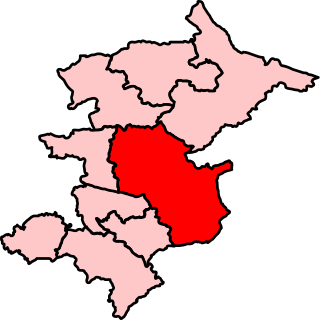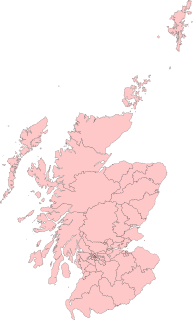This article does not cite any sources .(December 2009) (Learn how and when to remove this template message) |
A burgh constituency is a type of parliamentary constituency in Scotland. It is a constituency which is predominantly urban, and on this basis has been designated as a burgh constituency. They are the successors of the historic parliamentary burghs of the Parliament of Scotland.

In the United Kingdom (UK), each of the electoral areas or divisions called constituencies elects one member to the House of Commons.

Scotland is a country that is part of the United Kingdom. It covers the northern third of the island of Great Britain, with a border with England to the southeast, and is surrounded by the Atlantic Ocean to the north and west, the North Sea to the northeast, the Irish Sea to the south, and more than 790 islands, including the Northern Isles and the Hebrides.

An urban area or urban agglomeration, is a human settlement with high population density and infrastructure of built environment. Urban areas are created through urbanization and are categorized by urban morphology as cities, towns, conurbations or suburbs. In urbanism, the term contrasts to rural areas such as villages and hamlets and in urban sociology or urban anthropology it contrasts with natural environment. The creation of early predecessors of urban areas during the urban revolution led to the creation of human civilization with modern urban planning, which along with other human activities such as exploitation of natural resources leads to human impact on the environment.
In 1708 parliamentary burghs were allocated to districts of burghs, each district serving as a constituency of the Parliament of Great Britain. In the Parliament of the United Kingdom, from 1801 onwards, this district system continued until it was gradually abolished during the first half of the 20th century.
The Act of Union 1707 and pre-Union Scottish legislation provided for 14 Members of Parliament (MPs) from Scotland to be elected from districts of burghs. All the parliamentary burghs were assigned to a district, except for Edinburgh which had an MP to itself. The burghs in a district were not necessarily adjacent or even close together.

The Parliament of Great Britain was formed in 1707 following the ratification of the Acts of Union by both the Parliament of England and the Parliament of Scotland. The Acts created a new unified Kingdom of Great Britain and dissolved the separate English and Scottish parliaments in favour of a single parliament, located in the former home of the English parliament in the Palace of Westminster, near the City of London. This lasted nearly a century, until the Acts of Union 1800 merged the separate British and Irish Parliaments into a single Parliament of the United Kingdom with effect from 1 January 1801.

The Parliament of the United Kingdom of Great Britain and Northern Ireland, commonly known internationally as the UK Parliament, British Parliament, or Westminster Parliament, and domestically simply as Parliament or Westminster, is the supreme legislative body of the United Kingdom, the Crown dependencies and the British Overseas Territories. It alone possesses legislative supremacy and thereby ultimate power over all other political bodies in the UK and the overseas territories. Parliament is bicameral but has three parts, consisting of the Sovereign (Queen-in-Parliament), the House of Lords, and the House of Commons. The two houses meet in the Palace of Westminster in the City of Westminster, one of the inner boroughs of the capital city, London.
Modern burgh constituencies are much like county constituencies in the way that their boundaries are drawn, but election candidates are allowed lower expenses, as they do not need to travel as much. For British House of Commons elections, the allowance is £7,150 and 5p per elector. For by-elections, the allowance is always £100,000.
A by-election, also spelled bye-election, is an election used to fill an office that has become vacant between general elections.
House of Commons constituencies were formerly used for elections to the Scottish Parliament, created in 1999, but they have been de-linked since 2005, by reducing the number of Commons constituencies in Scotland without a corresponding change in the Scottish Parliament. The historic distinction between county and burgh constituencies is maintained in both sets of constituencies.

The Scottish Parliament is the unicameral legislature of Scotland. Located in the Holyrood area of the capital city, Edinburgh, it is frequently referred to by the metonym Holyrood.
For Scottish Parliament elections, the allowance is £5,761 and 4.8p per elector.
The following constituencies are designated as burgh constituencies in the Scottish Parliament:
- Aberdeen Central
- Aberdeen Donside
- Airdrie and Shotts
- Ayr
- Coatbridge and Chryston
- Dundee City East
- Dundee City West
- Edinburgh Central
- Edinburgh Eastern
- Edinburgh Northern and Leith
- Edinburgh Pentlands
- Edinburgh Southern
- Edinburgh Western
- Glasgow Anniesland
- Glasgow Cathcart
- Glasgow Kelvin
- Glasgow Maryhill and Springburn
- Glasgow Pollok
- Glasgow Provan
- Glasgow Shettleston
- Glasgow Southside
- Hamilton, Larkhall and Stonehouse
- Motherwell and Wishaw
- Paisley
- Rutherglen
- Uddingston and Bellshill

Aberdeen Central is a burgh constituency of the Scottish Parliament (Holyrood). It elects one Member of the Scottish Parliament (MSP) by the first past the post method of election. Also, however, it is one of ten constituencies in the North East Scotland electoral region, which elects seven additional members, in addition to ten constituency MSPs, to produce a form of proportional representation for the region as a whole.

Aberdeen Donside is a constituency of the Scottish Parliament (Holyrood). It elects one Member of the Scottish Parliament (MSP) by the first past the post method of election. Also, however, it is one of ten constituencies in the North East Scotland electoral region, which elects seven additional members, in addition to ten constituency MSPs, to produce a form of proportional representation for the region as a whole.

Airdrie and Shotts is a constituency of the Scottish Parliament. It elects one Member of the Scottish Parliament (MSP) by the plurality method of election. It is also one of nine constituencies in the Central Scotland electoral region, which elects seven additional members, in addition to ten constituency MSPs, to produce a form of proportional representation for the region as a whole.




